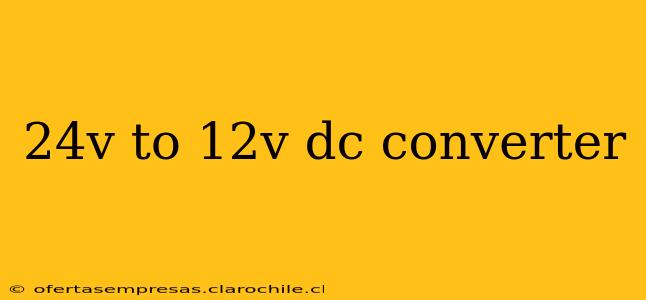Converting 24V DC to 12V DC is a common requirement in various applications, from automotive systems and industrial machinery to powering smaller devices from a higher voltage source. This guide explores the different types of 24V to 12V DC converters, their applications, and crucial factors to consider when choosing the right one for your needs.
What is a 24V to 12V DC Converter?
A 24V to 12V DC converter, also known as a DC-DC step-down converter or buck converter, is an electronic device that reduces a higher voltage (24V) to a lower voltage (12V) while maintaining the direct current (DC) nature of the power. This conversion is achieved through various electronic circuitry, typically involving switching elements like transistors and inductors, and control mechanisms to regulate the output voltage. The process efficiently converts the higher voltage power to the lower voltage while minimizing energy loss.
Types of 24V to 12V DC Converters
Several types of 24V to 12V DC converters exist, each with its advantages and disadvantages:
1. Linear Regulators:
These are simpler converters that use a transistor to dissipate the excess voltage as heat. They're easy to implement but inefficient, especially at higher currents, due to significant power loss as heat. They are generally unsuitable for high-power applications.
2. Switching Regulators (Buck Converters):
These are far more efficient than linear regulators. They rapidly switch the current on and off, using an inductor and capacitor to smooth the output voltage. Switching regulators are preferred for most applications due to their higher efficiency and ability to handle higher currents.
3. Isolated Converters:
These provide galvanic isolation between the input and output, meaning there's no direct electrical connection. This is crucial for safety reasons, particularly in applications where high voltages are involved or where isolation is necessary to prevent ground loops.
How to Choose the Right 24V to 12V DC Converter
Selecting the appropriate converter depends on several critical factors:
1. Output Current:
This specifies the maximum current the converter can supply at 12V. Ensure the converter's rated output current exceeds the current requirements of your load. Underestimating this can lead to insufficient power and potential damage to the converter or your device.
2. Efficiency:
Efficiency refers to how effectively the converter transforms the input power into usable output power. Higher efficiency translates to less heat generation and energy waste. Look for converters with high efficiency ratings, typically expressed as a percentage.
3. Input Voltage Range:
The input voltage range indicates the acceptable range of 24V input the converter can handle. Some converters have a narrow input range, while others offer wider tolerances, accommodating variations in the input voltage.
4. Regulation:
A well-regulated converter maintains a stable output voltage despite variations in the input voltage or load current. The regulation specification indicates how well the converter maintains its output voltage under varying conditions.
5. Size and Mounting:
Consider the physical size and mounting options of the converter to ensure compatibility with your application's space constraints.
What are the Applications of a 24V to 12V DC Converter?
24V to 12V DC converters find applications in various fields:
- Automotive Electronics: Powering 12V accessories in vehicles with a 24V system (common in trucks and heavy vehicles).
- Industrial Automation: Supplying power to 12V sensors, actuators, and controllers within a 24V industrial system.
- Telecommunications: Converting 24V power supplies to lower voltages for various telecommunication equipment.
- Renewable Energy Systems: Used to regulate the voltage from solar panels or other renewable energy sources.
- Security Systems: Powering 12V security cameras, alarms, and other components in a system operating at 24V.
What are the safety precautions when using a 24V to 12V DC converter?
Always prioritize safety when working with electrical components. Here are some important safety precautions:
- Ensure proper ventilation: Converters generate heat, so adequate ventilation is crucial to prevent overheating and potential damage.
- Use appropriate wiring: Use wires with sufficient gauge to handle the current, preventing overheating and fire hazards.
- Grounding: Proper grounding is essential for safety, especially in higher-voltage applications.
- Observe polarity: Always connect the converter according to the correct polarity (+ and -). Incorrect polarity can damage the converter or other equipment.
- Consult the manufacturer's specifications: Always refer to the converter's datasheet for detailed specifications, safety guidelines, and operating instructions.
This comprehensive guide provides a solid understanding of 24V to 12V DC converters, aiding you in choosing and using the correct device safely and effectively for your specific application. Remember to always prioritize safety and consult relevant datasheets for your specific converter.
